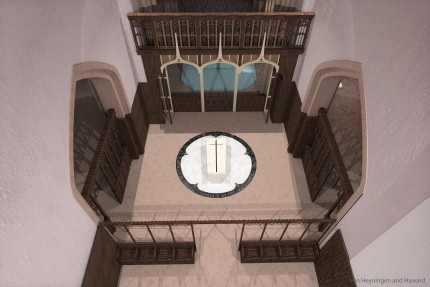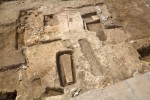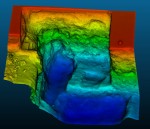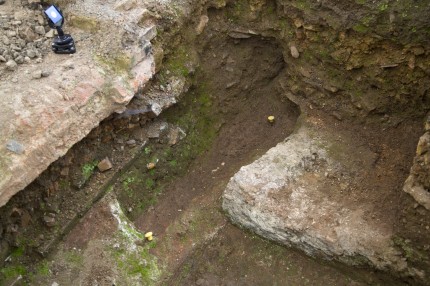Even as a legal challenge contesting the University of Leicester’s license to determine where the remains of King Richard III are to be buried winds its way through the courts, Leicester Cathedral is moving forward with its plans for the monarch’s tomb. The church originally proposed a modest floor-level slab tomb, but when they opened it to public consultation the response was less than positive. The Richard III Society declared themselves “appalled” by the design. The cathedral went back to the drawing board and came up with a far more ambitious plan.
The Dean of Leicester, The Very Revd David Monteith, said the plans were influenced by feedback from a variety of sources, including members of the public who had been visiting the Cathedral and commenting in the media.
“We are committed to reinter King Richard with honour and we have listened carefully to the different views that were expressed. We want to create a really wonderful space in the Cathedral for him and the many thousands of people we know will want to come to visit and pay their respects.
With input from the Richard III Society, the University of Leicester and the City Council, the firm of van Heyningen and Haward Architects is working on several designs for an elaborate tomb that is both king-worthy and that will accommodate the large number of visitors expected to flock to Richard’s new home. The architects have been working on renovations of Leicester Cathedral since 2009. When the remains of Richard III were discovered, the cathedral asked them to integrate the tomb into the reordering.
Instead of being flush with the floor, Richard’s tomb will be raised in the center of dedicated space with new floors, lighting and a new stained glass window. The precise design has yet to be finalized, but here’s an artist’s rendering of the prospective tomb:

The inlaid marble white rose of York under the raised sarcophagus is a particularly nice touch, I think.
It won’t come cheap. The estimated cost to construct the tomb is £1 million ($1,525,000), moneys which the cathedral is going to have to raise before construction begins. Final approval is slated for November and then they’re going to have to get a move on, because when the Ministry of Justice granted the University the license to remove the remains, they stipulated that the remains would have to be reinterred by August 31st, 2014. Any delays from fundraising, the legal challenge or construction could run afoul of the deadline.
 Meanwhile, the University of Leicester is back at the Greyfriars site. This time they’ve been able to open a far larger trench to accompany their far wider brief. The goals are to unearth more details about Richard’s final resting place, discover more about the layout of the church, unearth other burials in the church, most notably the stone coffin thought to contain the body of a local dignitary (perhaps the founder of the friary Peter Swynsfeld, perhaps a knight named Sir William Moton) and the remains of three friars who were hanged and beheaded by Henry IV for treason in 1402 after they were found to be spreading rumors that Richard II was still alive thereby
Meanwhile, the University of Leicester is back at the Greyfriars site. This time they’ve been able to open a far larger trench to accompany their far wider brief. The goals are to unearth more details about Richard’s final resting place, discover more about the layout of the church, unearth other burials in the church, most notably the stone coffin thought to contain the body of a local dignitary (perhaps the founder of the friary Peter Swynsfeld, perhaps a knight named Sir William Moton) and the remains of three friars who were hanged and beheaded by Henry IV for treason in 1402 after they were found to be spreading rumors that Richard II was still alive thereby undermining Henry’s legitimacy.
undermining Henry’s legitimacy.
The archaeological team has already found the outlines of the church walls and many medieval floor tiles, some reused in Robert Herrick’s 17th century garden, some still in situ in the choir floor. They’ve also re-excavated the stone coffin and Richard’s grave. The latter they scanned using laser and digital photogrammetric technologies to get the most detailed 3D map possible. Once the grave is covered up again so people can park their cars on it, archaeologists will have an interactive reconstruction to study and to use for comparison in any future excavations. It will also be part of the display at the new Richard III Visitor Centre being build adjacent to the former Greyfriars church.
on it, archaeologists will have an interactive reconstruction to study and to use for comparison in any future excavations. It will also be part of the display at the new Richard III Visitor Centre being build adjacent to the former Greyfriars church.
They’ve erected a public viewing platform at the north end of the parking lot which will be open every day between 9:00 AM and 4:00 PM until the end of July.
